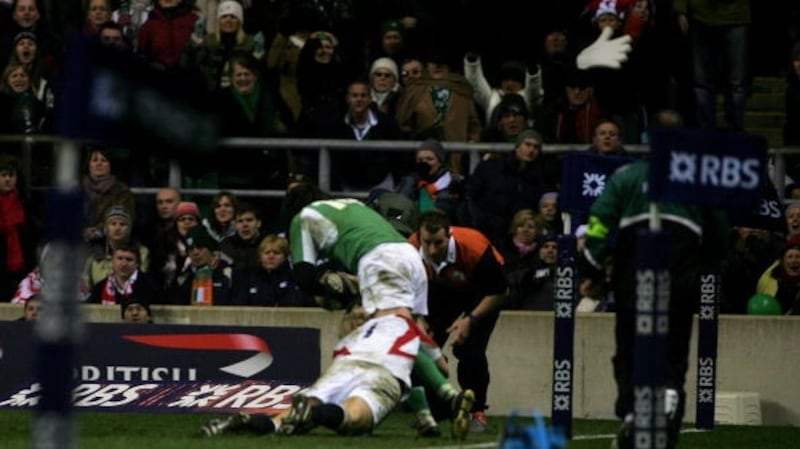Of all the bucket list destinations out there a trip to the world rugby museum at Twickenham might not be every Irish citizen’s first pick. Which is a shame. Yes, there are a few sepia-dipped images of olde English heroes with huge moustaches but any supporters over for Saturday’s big game will also discover some significant emerald-tinted artefacts.
There is the jersey, for example, worn by the Irish forward Harold Sugars in his country’s first international against South Africa in 1906, when Sugars scored two tries but Ireland still lost. There is also a salute to the evergreen (in every sense) Mike Gibson while Noel Murphy’s jersey from the 1959 Lions tour of New Zealand, complete with the jagged holes inflicted by assorted All Black studs, needs no additional subtitles.
The exhibit that really resonated the other day, though, was Moss Keane’s appropriately moss-coloured old shirt. Because it was Keane who featured in the game at Twickenham in 1982 that even now, 40 winters later, is remembered fondly by Irish rugby fans of all creeds and backgrounds as the crucial springboard to their team’s first Triple Crown for 33 years. The economic depression in Ireland was dispiritingly deep and, with unemployment rampant, spirits in Ireland were at a low ebb. Hence the excitement, with the great Ollie Campbell in his pomp, when Ireland went to Twickenham and won 16-15, with Gerry “Ginger” McLoughlin famously scoring the decisive try.

That night Keane went out for a few beers in Camden Town, still all dressed up in his dinner suit, and did not have to pay for a drink all night. At one point he bumped into an exiled builder, one of the legions forced to leave their homeland for work across the Irish Sea. “Moss, it’s an awful shame to see a big lump of a man like you wasted playing that ol’ rugby,” said his new friend. “You’d be a great man at feeding a cement mixer.” As recounted in No Borders, Tom English’s masterly first-person history of Irish rugby, Keane was forever struck by the numbers of displaced Irish working people resident in north London whom he was representing whenever he pulled on a green jersey. “I always thought of them when I was up against England.”
Which, in addition to the history-driven emotions invariably stirred whenever England face their Celtic neighbours, further helps to explain why Irish visits to Twickenham always have a distinct rattle and hum about them. At times the home of English rugby has been a bogey ground, which is why the glory days stand out loud and proud. Simon Geoghegan’s try in 1994, for example, helped to secure the only Ireland win in south-west London in a 22-year period until 2004, when the newly crowned world champions were toppled at home for the first time since 1999.
More recently there was Shane Horgan's tip-toe sideline nudge to ruin Ben Cohen's day in 2006 and the indelible memory of another flying green winger, Tommy Bowe, slicing irresistibly through, with seven minutes left and his side trailing, to clinch another stirring Irish win in 2010. The only other subsequent championship victory, however, was in 2018 when the in-form Jacob Stockdale helped a dominant Ireland clinch a deserved grand slam that left England languishing in fifth place in the championship table, their worst finish in 31 years.
In short, history would argue that conquering fortress Twickenham, regardless of the circumstances, is a consistent kitemark of quality for any self-respecting Ireland sides. So is winning a Triple Crown. Johnny Sexton was interviewed the other day after his side's loss in Paris and revealed he is mustard keen to win the latter, having done so only once (as part of the 2018 grand slam squad) in his 13 seasons in the side.
England, too, have managed to subdue all the other three home nations only twice in Eddie Jones's seven-season tenure, which goes to show how hotly contested the Six Nations continues to be. With France now steadily re-emerging as a global superpower it also reinforces how problematic the championship can be to win, even in a good year. Especially if you happen to be wearing white and everyone hates you.
This week, though, the boot feels as if it is slightly on the other foot. It is Ireland who beat New Zealand last autumn and who boast the more settled side. It is Ireland who also look the more cohesive unit, by virtue of their players being centrally contracted and, in many cases, able to play alongside each other regularly for Leinster.
And it is Ireland who, in some ways, are seeking to make the grandest statement. Win well and all roads will lead directly to the 2023 Rugby World Cup. Buckle under, against an England side who have stalled lately, and it will not only blow any lingering title hopes but prompt questions as to whether further research and development might yet be required.
Either way it will be seriously physical, with the hand of history on every green giant’s shoulders. For “Ginger” McLoughlin and Moss Keane read Tadhg Furlong and James Ryan, passionate competitors for whom a 2022 victory at Twickenham would be both a respectful nod to the boys of 1982 and a prized museum piece. Rugby’s landscape has altered substantially in the past 40 years but some things never change.
- Guardian



















